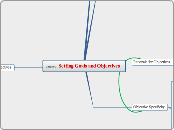Chapter 3: Setting Goals and Objectives
Key Points
Learning is a change in an individual's capacity to perform as a result of experience
Learning must have direction and purpose
Needs of Students
Be aware that students perform at different levels
Individualized education plan (IEP) have specific goals and state specific needs of the student and the plan of action for that student
All students should be mainstreamed as allowable
Increased diversity has lead to more Limited English Proficiency (LEP) students in classes
English Language Learners (ELL) and Limited English Proficient (LEP)
Students who have yet to fully grasp English
Students are learning English as a Second Language (ESL)
Rationale for Objectives
Objective: statement of what your students should be able to do after instruction
Communication of Intent is a key part of objectives
Must have clear ojbectives to set up proper evaluation of what students have learned
Objective Specificity
Objectives are narrow statements of the intended learning of a unit or specific lesson
Three levels of specificity
1- Educational Goals
broad and may take a longer period of time to complete
overarching goal
2- Instructional Objectives
Precisely communicate learning intent on three components: Behavior, Conditions and Criterion
Specify performance, the final product, the conditions of performance and the criteria for performance
3- Informational Objectives
Abbreviated instructional objectives that specify only the student perfomance and the product
better to share with students than instructional objectives because they are simpler
Objectives should be presented at the begining of a unit and be clearly shown in written form
Taxonomies of Objectives
Three Domains of Learning
1- Cognitive
ability to recall information
Bloom's Taxonomy
6 Levels from simple to complex
Knowledge
Comprehension
Application
Analysis
Synthesis
Evaluation
2- Affective
emotional repsonse to the task
Krathwohl's Levels
5 Levels from simple to complex
Receiving
Responding
Valuing
Organization
Characterization by value
3- Psychomotor
Four Levels from Simple to Complex
Fundamental Movement
Generic Movement
Ordinative Movement
Creative Movement
